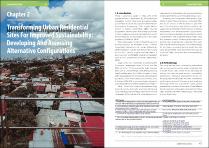 ResearchSpace
ResearchSpace
Transforming urban residential sites for improved sustainability, developing and assessing alternative configurations
JavaScript is disabled for your browser. Some features of this site may not work without it.
- ResearchSpace
- →
- Research Publications/Outputs
- →
- Conference Publications
- →
- View Item
| dc.contributor.author |
Gibberd, Jeremy T

|
|
| dc.contributor.editor | De Jager, Peta | |
| dc.date.accessioned | 2021-11-17T18:12:54Z | |
| dc.date.available | 2021-11-17T18:12:54Z | |
| dc.date.issued | 2021-07 | |
| dc.identifier.citation | Gibberd, J.T. 2021. Transforming urban residential sites for improved sustainability, developing and assessing alternative configurations. In <i>Sustainability handbook: Volume 2</i>. P. De Jager, Ed. S.l.: Alive2Green. http://hdl.handle.net/10204/12157 . | en_ZA |
| dc.identifier.isbn | 978-0-620-452403 | |
| dc.identifier.uri | http://hdl.handle.net/10204/12157 | |
| dc.description.abstract | Africa is urbanizing rapidly. In 1960, 20% of the population lived in urban areas. By 2010, 40% of the population lived in urban areas and annual urban growth rates of 4 to 5% are projected (United Nations Environment Programme, 1999; United Nations Centre for Human Settlements, 2002). Housing programmes have not been able to keep up with this growth, resulting in large informal settlements, which are estimated to accommodate 62% of the urban population (UNHabitat, 2014).Rapid urbanisation is evident in South Africa where housing backlogs are estimated to be 2.2 million households (Department of Human Settlements,2019). Projections indicate that demand for housing in cities will continue to grow and that there is a particular need for affordable rental accommodation close to work (Department of Human Settlements, 2019).South Africa has committed to achieving the Sustainable Development Goals (SDGs) by 2030. The SDGs consist of 17 developmental goals covering areas such as climate change, water, energy, housing, health and education. South Africa¿s progress in terms of the Sustainable Development Goals is being tracked by Statistics South Africa (Statistics South Africa, 2019). A selection of the SDG targets and progress relevant to urban and built environments are presented in Table 1. Table 1 shows that South Africa experiences high levels of poverty and youth unemployment and a significant proportion of the population live in informal settlements. It also indicates that while the provision of water, electricity and sanitation has improved, backlogs still exist and that the use of renewable energy is low. | en_US |
| dc.format | Fulltext | en_US |
| dc.language.iso | en | en_US |
| dc.publisher | Alive2Green | en_US |
| dc.relation.uri | http://sustainability-handbook.alive2green.co.za/current-issue/ | en_US |
| dc.relation.uri | https://indd.adobe.com/view/a7e9b215-37da-48fe-9492-87e0ef4c7c53 | en_US |
| dc.source | Sustainability handbook: Volume 2 | en_US |
| dc.subject | Geotechnical engineering | en_US |
| dc.subject | Energy projects | en_US |
| dc.title | Transforming urban residential sites for improved sustainability, developing and assessing alternative configurations | en_US |
| dc.type | Book Chapter | en_US |
| dc.description.edition | Volume 2 | en_US |
| dc.description.pages | 46-57 | en_US |
| dc.description.placeofpublication | Cape Town | en_US |
| dc.description.cluster | Smart Places | en_US |
| dc.description.impactarea | Infrastructure Innovation | en_US |
| dc.identifier.apacitation | Gibberd, J. T. (2021). Transforming urban residential sites for improved sustainability, developing and assessing alternative configurations. In P. De Jager. (Ed.), <i>Sustainability handbook: Volume 2</i> Alive2Green. http://hdl.handle.net/10204/12157 | en_ZA |
| dc.identifier.chicagocitation | Gibberd, Jeremy T. "Transforming urban residential sites for improved sustainability, developing and assessing alternative configurations" In <i>SUSTAINABILITY HANDBOOK: VOLUME 2</i>, edited by Peta De Jager. n.p.: Alive2Green. 2021. http://hdl.handle.net/10204/12157. | en_ZA |
| dc.identifier.vancouvercitation | Gibberd JT. Transforming urban residential sites for improved sustainability, developing and assessing alternative configurations. In De Jager P, editor.. Sustainability handbook: Volume 2. [place unknown]: Alive2Green; 2021. [cited yyyy month dd]. http://hdl.handle.net/10204/12157. | en_ZA |
| dc.identifier.ris | TY - Book Chapter AU - Gibberd, Jeremy T AB - Africa is urbanizing rapidly. In 1960, 20% of the population lived in urban areas. By 2010, 40% of the population lived in urban areas and annual urban growth rates of 4 to 5% are projected (United Nations Environment Programme, 1999; United Nations Centre for Human Settlements, 2002). Housing programmes have not been able to keep up with this growth, resulting in large informal settlements, which are estimated to accommodate 62% of the urban population (UNHabitat, 2014).Rapid urbanisation is evident in South Africa where housing backlogs are estimated to be 2.2 million households (Department of Human Settlements,2019). Projections indicate that demand for housing in cities will continue to grow and that there is a particular need for affordable rental accommodation close to work (Department of Human Settlements, 2019).South Africa has committed to achieving the Sustainable Development Goals (SDGs) by 2030. The SDGs consist of 17 developmental goals covering areas such as climate change, water, energy, housing, health and education. South Africa¿s progress in terms of the Sustainable Development Goals is being tracked by Statistics South Africa (Statistics South Africa, 2019). A selection of the SDG targets and progress relevant to urban and built environments are presented in Table 1. Table 1 shows that South Africa experiences high levels of poverty and youth unemployment and a significant proportion of the population live in informal settlements. It also indicates that while the provision of water, electricity and sanitation has improved, backlogs still exist and that the use of renewable energy is low. DA - 2021-07 DB - ResearchSpace DP - CSIR ED - De Jager, Peta J1 - Sustainability handbook: Volume 2 KW - Geotechnical engineering KW - Energy projects LK - https://researchspace.csir.co.za PY - 2021 SM - 978-0-620-452403 T1 - Transforming urban residential sites for improved sustainability, developing and assessing alternative configurations TI - Transforming urban residential sites for improved sustainability, developing and assessing alternative configurations UR - http://hdl.handle.net/10204/12157 ER - | en_ZA |
| dc.identifier.worklist | 25022 | en_US |





